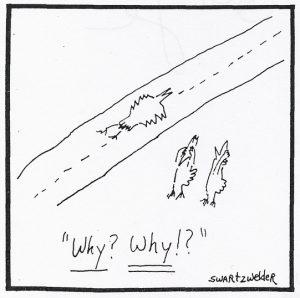Literature
64 Close Reading for Literature

In addition to using reading comprehension skills such as predicting, “talking to the text,” skimming a textbook before reading, and noting patterns and context clues, another strategy called “close reading” is helpful. This is popular with literature instructors; however, the skills involved in close reading are applicable to any complex reading assignment.
Titles
Titles, for starters, particularly of non-fiction works, may tell you what the main idea, or thesis, is. For example, a book about “The History of the Roman Empire” usually gives you just that—the history of the Roman Empire.
This is not usually true, however, for works of fiction, for which inference is the key to comprehension. For example, “Story of an Hour,” by Kate Chopin, while it might seem to be something about time, also suggests it is about something other than a clock ticking away seconds and minutes, and indeed it is.
Author
Many people are familiar with Stephen King, who writes in the horror genre. Knowing this element lets the reader know to anticipate (and predict) a horror story with a lot of plot twists and turns in some horrible ways. Prediction has begun.
Knowing about the remaining elements—plot, characters, and setting—help the reader close in on meaning enough to be able to discuss the theme or themes of the work with reasonable evidence to support one’s conclusion.
Inference
We can do close reading of small passages, individual sentences, and even specific words. Each level of careful attention and thought helps a reader “read between the lines” when meaning is not overtly stated, when themes are inferred rather than explained outright. This is called inference.
Ideoms
Idioms are good examples of inference, or “reading between the lines.” They also employ the comparison skill called metaphor (comparing two things without using the terms “like” or “as”).
Write out as many meanings for the list of idioms below as you can:
- Keep it under your hat.
- Over the hill.
- Barking up the wrong tree.
- Paint the town red.
- Lion’s share.
- Up a creek without a paddle.
- Eyes are bigger than your stomach.
- Put your nose to the grindstone.
- Keep your shoulder to the wheel.
- Running on empty.
- Too many irons in the fire.
- Spitting image.
- Born with a silver spoon in his mouth.
- Wild goose chase.
- Clear sailing.
- Walking on cloud nine.

Cartoons, especially editorial cartoons, also make good use of inference skills. For the cartoon, below, answer the questions about each of its elements to get to the meaning. Cartoons, like other forms of art, include additional visual elements such as facial expressions and setting. Many of us are able to comprehend cartoons within a few seconds just because we have so many inference skills already in our “hard drives,” so to speak, but examining them now will be a good reminder of how to comprehend complex subject matter—by close examination of all of the elements.
- Setting:
- Subject (what’s going on):
- Facial expression(s):
- Quote:
- Meaning of quote (inference):
Text Attributions
- This chapter was adapted from “Lesson 3.4: Close Reading for Literature” in How to Learn Like a Pro! by Phyllis Nissila, which is licensed under a CC BY 4.0 Licence. Adapted by Allison Kilgannon. Licensed under a CC BY-NC 4.0 Licence .
Media Attributions
- Books by Wokandapix is licensed under a CC0 Licence.
- John Swartzwelder cartoon by rubbercat is licensed under a CC BY-ND 4.0 Licence.
in = towards
fer = carry
means to carry us towards a meaning
bring in outside information and reach our own conclusion

